Insights and news from the ATOM Mobility team
We started our blog to share free valuable information about the mobility industry: inspirational stories, financial analysis, marketing ideas, practical tips, new feature announcements and more.
We started our blog to share free valuable information about the mobility industry: inspirational stories, financial analysis, marketing ideas, practical tips, new feature announcements and more.
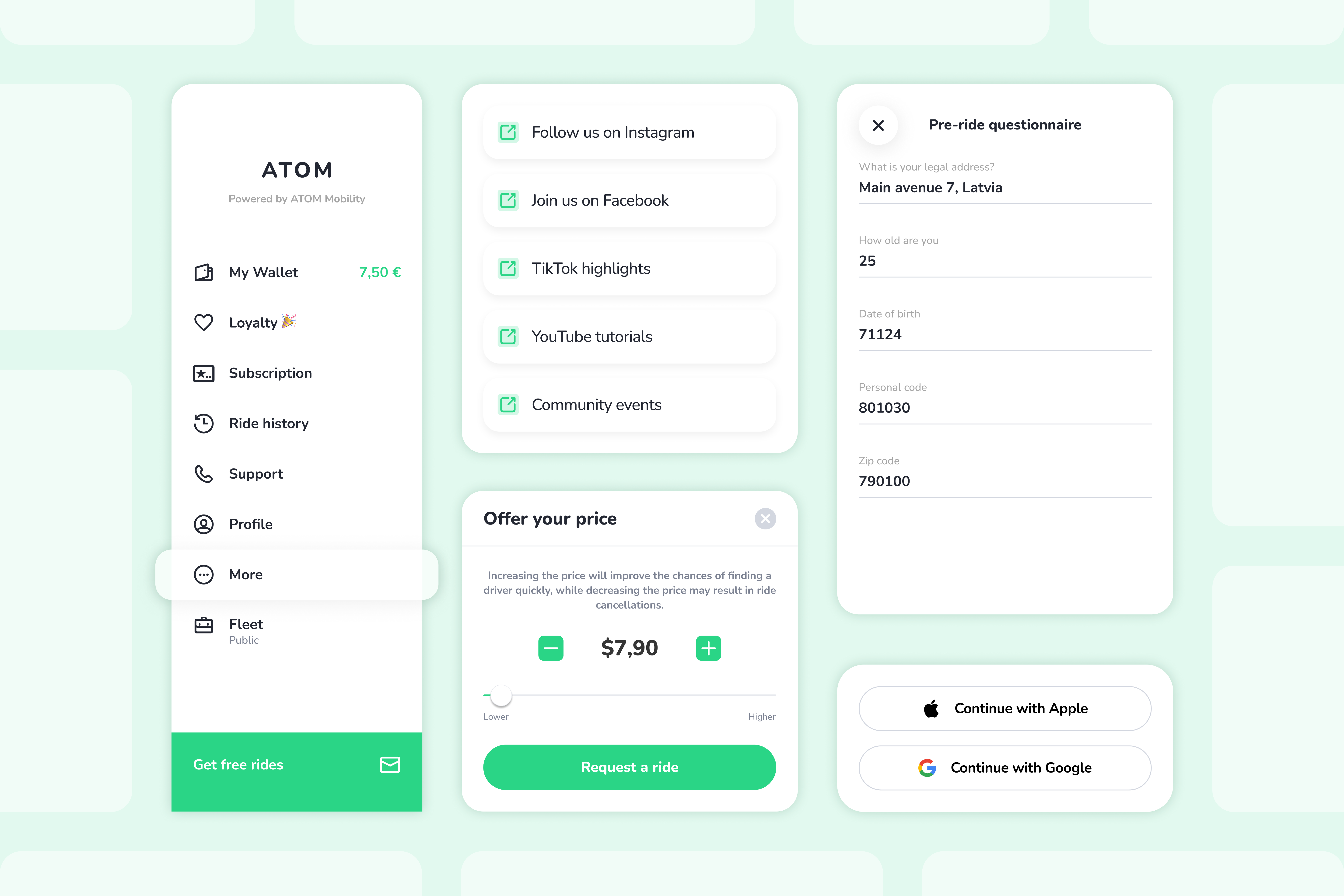
🚀📱2025 was all about automating more and reducing friction across mobility. ATOM Mobility introduced OpenAPI, new sign-in flows, a rental web-booker, smarter fleet automation, and a wide range of new hardware and payment integrations. A faster, more flexible, more scalable mobility platform - built for operators who want to grow.
2025 has been a defining year for shared mobility, digital rentals, and ride-hailing. Competition is stronger, operational costs are rising, and users expect instant, reliable digital experiences. Operators who succeed are the ones who automate more, reduce friction, and stay flexible with hardware, payments, and integrations.
This year, ATOM Mobility shipped a series of features designed to help operators achieve exactly that:
grow revenue, reduce costs, improve fleet quality, and scale into new markets with less complexity.
Here are the 10 most impactful (out of more than 70) features ATOM Mobility released in 2025, and why they matter.

The launch of ATOM’s OpenAPI marks a major step forward for operators seeking greater flexibility, automation, and integration possibilities.
What it is
A fully documented API layer allowing operators and partners to build custom flows, integrations, booking systems, analytics dashboards, or MaaS connections on top of ATOM Mobility.
Who it helps
All verticals: micromobility, car-sharing, moped sharing, rentals, ride-hail, and enterprise partners.
How it works
OpenAPI enables third-party developers to build on top of the ATOM Mobility infrastructure, allowing seamless integrations with external apps, internal tools, and automated workflows. With OpenAPI, operators can extend their service in almost any direction: a partner app (like FreeNow or Uber) can show your vehicles, unlock them, and process payments on your behalf; or internal systems can trigger automated actions - such as sending a survey email after every completed ride. The possibilities are nearly unlimited, giving operators full flexibility to innovate and scale however they choose.
Why it matters
- Enables deeper integrations with partners and local platforms
- Supports custom business logic and automations
- Makes it easier to enter new markets with local-specific requirements
- Opens the door to MaaS distribution and enterprise collaborations

Across mobility, the registration flow is often the first point of friction. ATOM Mobility introduced modern authentication options to simplify onboarding.
What it is
One-tap sign-in using Apple ID or Google Account instead of relying solely on SMS verification.
Who it helps
All operators - especially those targeting tourists, or markets with unreliable SMS delivery.
How it works
When creating a new account or logging in, users can choose to log in/register using Apple ID or Google Account - this will allow account creation in just 2 taps.
Why it matters
- Faster user onboarding experience -> happier rider -> more frequent rides
- Fewer SMS-related issues (and lower SMS related costs) and failed verifications
- Reduced support load from login problems

What it is
A customizable slot in the app menu where operators can add up to five external links - websites, ecommerce pages, tour pages, extra FAQ pages, social media, partner offers, etc.
How it works
- Enable in Settings → System preferences → External links
- Add titles + URLs
- Links automaticaly appear in the app under “More”
Value for operators
- A space where you can display any information you consider important for the user
- Supports cross-promotion and partnership campaigns
- Allows communication updates without app releases
- Creates additional monetisation opportunities, such as launching your own e-commerce or merchandise shop
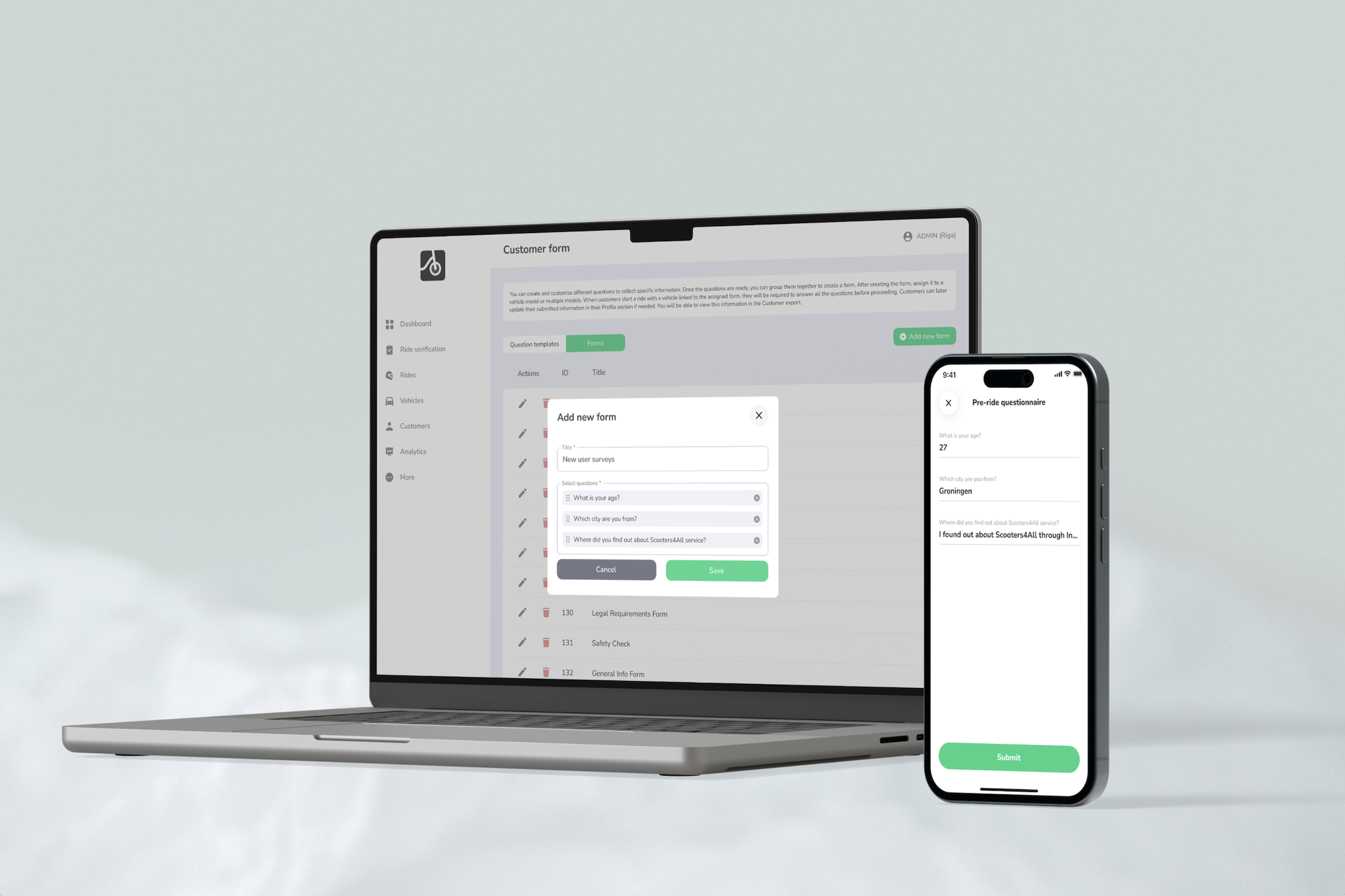
What it is
A form that users must complete before starting a ride - ideal for compliance, reporting, invoicing, or gathering important data.
Who it helps
Operators needing regulatory data, reporting, consent collection, or structured user feedback.
How it works
Create a question (or several) in “Customer form” -> Group questions into a pre-ride form -> Assign a form to specific vehicle models/classes.
Once completed, the customer must answer predefined questions before starting the ride. Their responses appear in both customer and ride exports. For example, you can ask for a personal ID code, legal address, or any other required information.
Value for operators
- Helps meet regulatory or municipal requirements
- Ensures correct invoicing details
- Provides a structured way to capture essential user data
What it is
Automatic payout splitting: driver earnings go to the driver’s payout account, and platform commission goes to the operator - all processed automatically after each ride.
Who it helps
Ride-hail operators using Stripe or Adyen.
How it works
- Operator has a Stripe/Adyen merchant account
- Drivers onboard as payout recipients
- After completed rides, payouts split automatically
- Supports mixed payment methods (cash and non-cash)
Value for operators
- Reduces manual payout work
- Minimises accounting errors
- Improves driver experience through transparency and instant pay out
- Makes scaling easier when the driver base grow
What it is
A tool to override or manually set a vehicle’s GPS position when IoT data is unavailable (no IoT placed on the vehicle at all) or inaccurate.
Who it helps
Operators with underground parking, poor GPS coverage, or long-term rentals without IoT can use this setup. A typical scenario is long-term bike rental without IoT: the user completes ID verification, payment, and booking in the app, then sees the vehicle assigned to a predefined location (station) where it is picked up and later returned. This serves as a workaround for vehicles that do not support IoT or where adding IoT device is too costly.
How it works
Edit vehicle → update “Location” field. The system assumes this as the correct coordinate. Works for individual vehicles or via mass import.
Value for operators
- Avoids user frustration when vehicles appear in the wrong location
- Supports business modesl with fleets operating without IoT devices
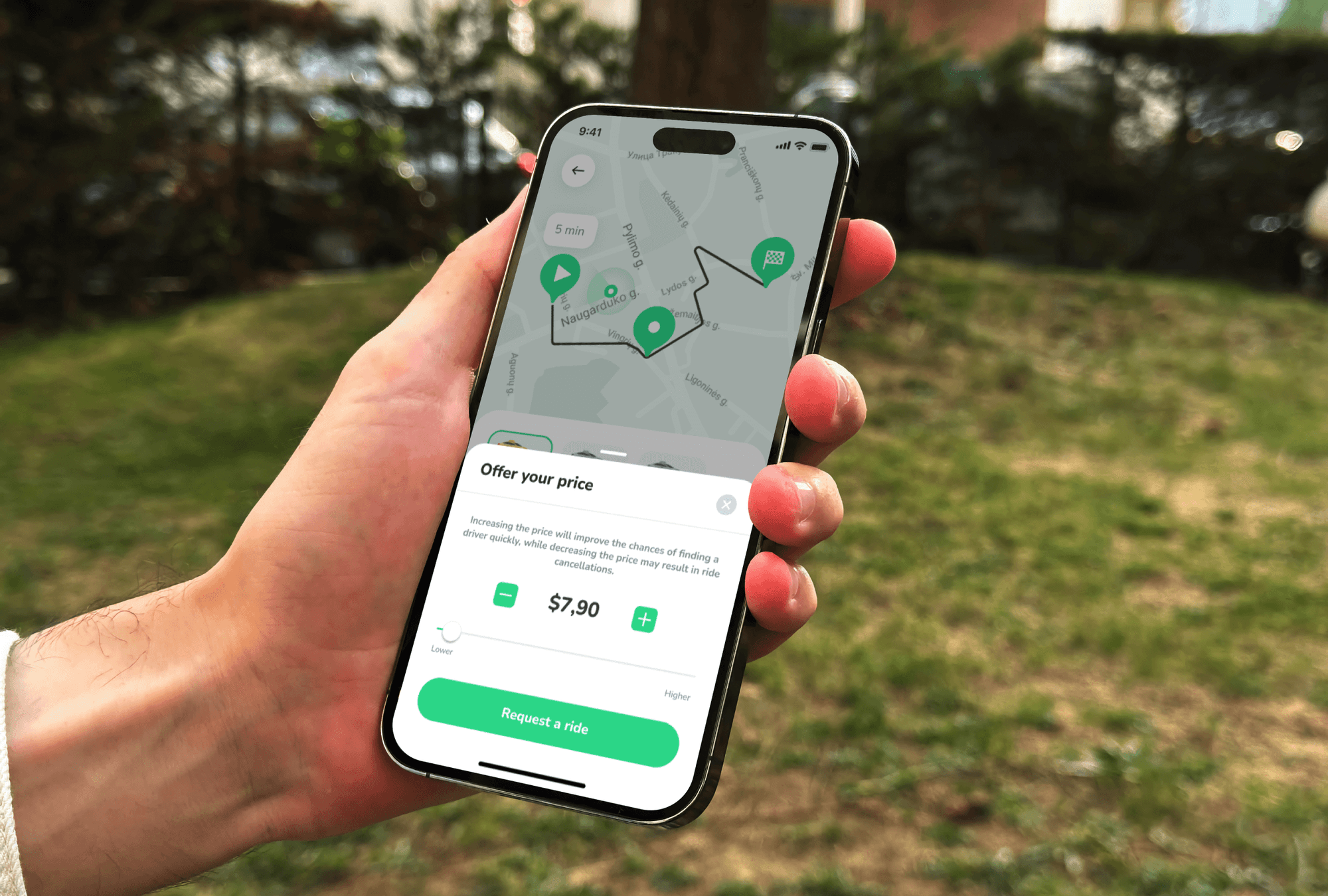
What it is
A flexible pricing feature that lets passengers propose their own fare - higher or lower than the system-calculated price, within limits set by the operator. Drivers see the offer instantly and can choose to accept or reject it.
Who it helps
Ride-hailing operators in competitive, price-sensitive, or highly dynamic markets where price shifts demand quickly.
How it works
When requesting a ride, the user selects “Offer your price”. A slider or +/– buttons allow them to adjust the fare within operator-defined boundaries. If the user lowers the price, the app explains that the offer may reduce the chance of driver acceptance.
Drivers see a clear banner showing whether the rider is offering more or less than the standard fare. Drivers can accept or decline based on their preference.
Operators can enable or disable the feature per vehicle class.
Why it matters
- Creates a clear differentiator in markets dominated by fixed-fare competitors
- Helps convert riders who compare multiple apps before booking
- Gives drivers more control over their earnings and decisions, improving transparency and satisfaction
- Supports better ride matching during off-peak hours or less profitable routes
- Allows operators to experiment with more flexible pricing strategies without changing their core fare model
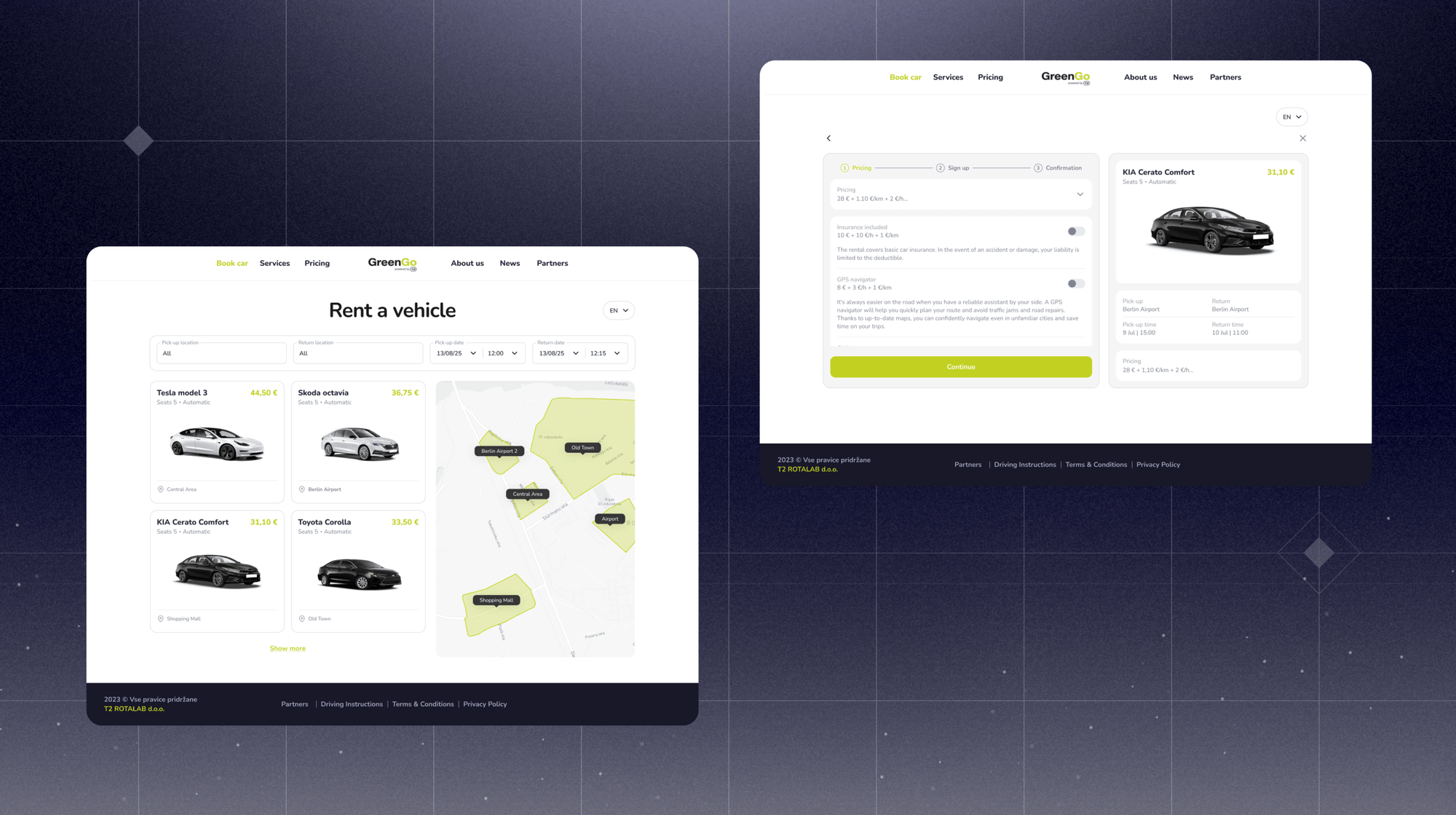
What it is
A lightweight, embeddable booking widget that lets customers reserve a rental vehicle directly from your website - without installing the mobile app first. It’s designed to capture spontaneous bookings, convert website visitors, and unify online and in-app rental experiences.
Who it helps
Car, moped, and bike rental operators, as well as hospitality and tourism partners such as hotels, resorts, coworking spaces, real-estate developers, and travel service providers.
How it works
Every operator receives a branded rental URL: merchantname.atommobility.com/rent
Users select their area, vehicle type, and rental period directly in the widget. Once confirmed and the account created, the booking syncs automatically into the ATOM Mobility dashboard. Customers see a confirmation screen with a QR code to open the booking in the mobile app. Payment, ID verification, and vehicle unlock actions are completed in the ATOM Mobility-powered app before the trip begins.
The widget automatically adapts to the operator’s brand color for a visually seamless integration. In the dashboard, each booking displays its source: App, Web, or Booker - helping operators track where rentals originate.
Why it matters
- Converts first-time users browsing your website into paying customers - without forcing an app install
- Enables plug-and-play rental flows for partners such as hotels, rental desks, cafés, coworking spaces, or tourist spots
- Supports QR-based rental journeys from physical locations
- Reduces friction for users who want a fast, simple booking experience
- Helps operators expand distribution with minimal effort, unlocking new sales channels
- Unifies online and mobile rental flows under a single backend and operational system
Demo: https://app.atommobility.com/rental-widget
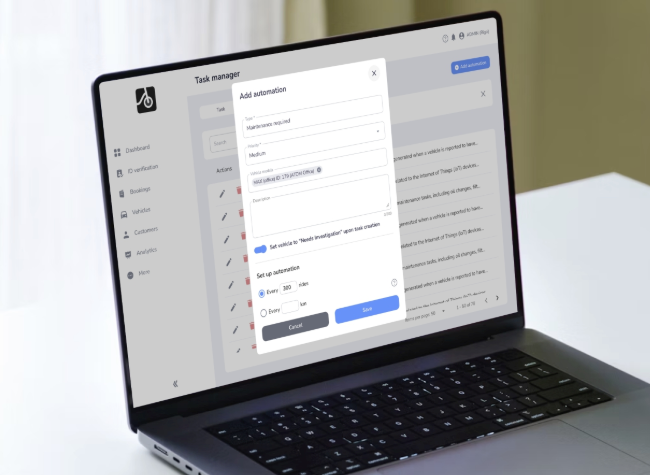
What it is
Bad user experiences often happen when several riders encounter the same faulty vehicle. ATOM Mobility now prevents this automatically. Automation rules detect problematic vehicles and instantly set them to “Needs investigation,” hiding them from the user app so the operator can inspect the vehicle before the next rider can take it.
Who it helps
Sharing and rental operators managing medium or large fleets.
How it works
System monitors low ratings, repeated short rides, and user reports. When triggered, it:
- creates a maintenance task
- switches vehicle status
- hides the vehicle from users
Why it matters
- Prevents recurring complaints from the same issue
- Reduces refunds and reputational damage
- Helps maintain a healthier, more reliable fleet
- Automates routine operational checks
What was added
2025 brought a wave of new integrations that give operators more flexibility in choosing hardware, payments, charging, and regulatory tools. What was added:
- Ridemovi IoT
- Wave payment gateway
- Linka smart lock support
- 2Hire IoT
- Kuhmute charging stations
- Eskiz.uz OTP service
- Atmos payment gateway
- Chiron API (regulatory)
- Fitrider charging station
- Azericard payment gateway
Why it matters
- Easier entry into markets with local payment or OTP requirements
- More hardware options for scooters, bikes, e-bikes, and cars
- Better compatibility with charging infrastructure
- Reduced integration time when expanding
- Support for regulatory compliance where required
These ten features represent only a small selection of what we delivered this year. In total, our team shipped more than 70 new features, dozens of integrations, and countless small improvements that quietly make the platform faster, more stable, and more enjoyable for operators and end-users every single day. Behind each release is a team focused on one idea: helping entrepreneurs build stronger, more efficient, and more profitable mobility businesses.
And we’re just getting started.
Our 2026 tech pipeline is already packed with ambitious and exciting solutions - from deeper AI-powered automation to smarter fleet intelligence and new tools that will change how operators run mobility services. We're looking forward to pushing the industry even further together.

At ATOM Mobility, we’re always looking for ways to improve the user experience. One of the most requested features from our customers has been alternative login options. And now, we’re happy to announce that Apple and Google sign-in options are finally here!
Most mobile apps rely on phone number verification for sign-ups and logins. This is also the case for ATOM Mobility, where users verify their phone number using a One-Time Password (OTP). We use trusted partners like Twilio, Dexatel, and others to ensure secure phone verification. Big companies like Uber, Bolt, and inDrive also follow this method because it helps prevent fraud and unauthorized access.
However, we know that not everyone wants to use their phone number every time they log in. Some users prefer quicker options, especially if they’re alreadyuse Apple or Google on their devices. That’s why we’ve now added these alternatives.

According to global data, a significant number of people prefer logging in with their existing accounts rather than typing in a phone number. Research shows that about 60-80% of users choose social logins if given the option. That’s a huge number! By adding Apple and Google login, we’re making it even easier for users to sign up and start using your app instantly.
Many popular apps and platforms already offer these sign-in options because they reduce the time it takes for users to access services. The fewer steps involved, the more likely users are to complete registration rather than abandoning the process midway. For businesses, this translates to higher conversion rates and more engaged users.
Adding Apple and Google login options isn’t just about convenience. It has real benefits for operators as well:
It’s important to note that phone number verification still plays a big role in fraud prevention. If users sign in without verifying their number, there’s a higher risk of fake accounts. That’s why we’re keeping the OTP method as the default while offering Apple and Google login as an alternative.
Many companies, including ATOM Mobility, prioritize fraud prevention. While Apple and Google sign-in reduce the risk of failed logins, they also require additional monitoring to ensure that the platform remains secure. Implementing fraud detection measures alongside these sign-in options can help maintain a balance between user convenience and platform security.
The updated login screen will now include Apple and Google sign-in buttons alongside the phone number option. Users can choose their preferred method, making the process faster and more flexible.
If you are an ATOM Mobility customer, enabling this feature in your app settings is simple. Once activated, users will see the Apple and Google login buttons immediately when they open the app. This small but powerful change can lead to more completed registrations and a smoother onboarding experience.
This is just one of the many improvements we’re bringing to ATOM Mobility. We’re constantly working on new features to enhance the user experience and streamline operations. Check out our other top features:
At ATOM Mobility, we believe in continuous innovation. Now that Apple and Google login options are live, we are exploring other ways to simplify user access and improve security. Some potential future developments include:
With Apple and Google login now available, signing up for ATOM Mobility-powered apps is easier than ever. Whether users prefer OTP verification or a simple one-tap login, they now have more choices. This update is all about making the experience smoother and increasing the number of successful registrations.
If you’re an ATOM Mobility customer, make sure to enable this feature and give your users the flexibility they want. And if you need any help, feel free to reach out to our team!
Stay tuned for more updates as we continue to improve the platform!
%20(1).png)
🚲 Donkey Republic is proving that bike-sharing can be profitable, while many competitors are struggling to stay on the road to success. Donkey Republic is partnering with cities, keeping costs low, and focusing on bikes. With more cities pushing for car-free mobility, can Donkey Republic continue to grow?
Bike-sharing has had a wild ride over the past ten years. Some companies threw thousands of bikes onto city streets without permission, while others spent tons of money but couldn’t figure out how to make a profit. Donkey Republic took a different approach—and it worked.
Started in Copenhagen in 2014, Donkey Republic didn’t rush to expand or rely on big investors. Instead, it focused on working with cities, keeping things simple, and making sure the business could actually make money. In 2023, the company earned €15.4 million (DKK 115.2 million), up 70% from the previous year, and, more importantly, it made a profit of €1.27 million (DKK 9.5 million).
The company’s founder, Erdem Ovacik, got the idea when he saw a friend using combination locks to share bikes with others in Copenhagen. He figured there had to be a better way. The answer? A mobile app and smart locks, so people could rent a bike quickly without needing a docking station.
In 2015, Donkey Republic started with just 30 bikes. Instead of flooding the streets with bikes and hoping for the best, it worked directly with city governments to get approval. That helped avoid the problems that companies like Ofo and Mobike faced when they expanded too fast and then collapsed.
A lot of bike and scooter companies try to grow as fast as possible, spending loads of money and hoping to make a profit later. Donkey Republic didn’t do that. By 2020, it had expanded to 13 countries, including Germany, Spain, the Netherlands, and Finland, but always in a controlled way.
A big part of its success comes from working with cities instead of fighting them. Instead of just dropping bikes on the street and hoping no one complains, Donkey Republic made agreements with local governments. This means the company doesn’t have to worry as much about sudden bans or changing rules.
For example, in 2023, Paris banned rental e-scooters, which was a disaster for other companies. But because Donkey Republic focuses on bikes, it wasn’t affected.
Donkey Republic has shown impressive financial progress in recent years. In 2023, the company reported a revenue of DKK 115.2 million – a 70% increase compared to the previous year. Even more importantly, they achieved a positive EBITDA (Earnings before interest, taxes, depreciation, and amortization) of DKK 9.5 million, marking a shift toward profitability.

2024 has been even stronger for Donkey Republic. The company reported a revenue of DKK 145 million, representing a 25% increase from 2023. For the first time, they also recorded a positive EBIT of DKK 1 million. This shows that their long-term strategy of working with cities and optimizing operations is paying off.
Several factors have contributed to Donkey Republic’s success:
While Donkey Republic has shown that micromobility can be profitable, the road ahead isn’t without challenges. Competition is fierce, and other companies are rapidly expanding their e-bike fleets to compete in Donkey Republic’s space. Additionally, while city partnerships provide stability, they also limit rapid expansion – municipal contracts take time to secure, and some cities prefer to invest in their own public bike-sharing programs.
Still, Donkey Republic is betting that the demand for sustainable, city-friendly transport will only grow. With urban areas across Europe cracking down on car use – such as London’s Ultra Low Emission Zone (ULEZ) and Paris’s car-restriction policies – bike-sharing is well-positioned to thrive.
So while scooter operators continue to battle regulatory headaches and profit struggles, Donkey Republic is proving that a disciplined, city-first approach might just be the key to lasting success in micromobility.

🚗📉 Why do big car brands struggle in carsharing while independent startups thrive? OEMs like Volvo and SEAT have shut down, but new players like Kia are stepping in with smarter strategies. Meanwhile, independent operators like GreenMobility are scaling fast. 🔍 What’s the secret to success in carsharing? It’s all about adaptability, cost control, and tech partnerships.
The carsharing industry is at a crossroads. Once hailed as the future of urban mobility, it has seen a mix of success and failure, with some players thriving and others closing shop. So we ask: why do some carsharing ventures fail while others continue to grow? And more importantly, what does it take to run a sustainable and profitable carsharing business in today’s competitive landscape?
Recent developments have been telling. Two OEM-backed carsharing ventures have recently shut down, while independent operators continue to expand, and a new entrant – Kia – has just launched its own service. This article takes you into the challenges, key success factors, and the evolving role of technology in the industry.
Before diving into specific cases, it’s important to clarify what OEMs (Original Equipment Manufacturers) are and how they differ from startups. OEMs are traditional car manufacturers – companies like Kia, Volvo, or Ford – that primarily produce and sell vehicles under their brand names. Some OEMs have expanded into mobility services, including carsharing, but often struggle because their main focus remains on car sales.
In contrast, startups and independent operators like GreenMobility are built from the ground up as mobility service providers. They don’t manufacture cars but instead focus entirely on the carsharing experience, optimizing operations, technology, and customer service. This difference in core focus often determines success or failure in the carsharing industry.
Automakers have long recognized the potential of carsharing as a way to diversify revenue streams, enhance brand loyalty, and explore new mobility business models. However, history has shown that simply putting cars on the streets and creating an app isn’t enough to make carsharing work.
Several OEM-backed carsharing services have struggled to maintain profitability. Volvo’s Volvo On Demand recently announced its closure as part of a broader strategy to optimize costs. Similarly, SEAT ceased operations at the end of 2024 due to declining demand and rising operational costs (€31 million total losses, with €11 million lost in 2023 alone, against a turnover of €16 million).
The challenges OEMs face in carsharing stem from several factors:
However, these closures don’t necessarily mean that carsharing itself is an unsustainable model. Instead, they highlight the need for a different approach – one that independent players are executing more effectively.

While OEM carsharing ventures struggle, independent operators like GreenMobility are experiencing growth. Unlike traditional automakers, these companies are built from the ground up as mobility service providers, allowing them to operate more efficiently.
GreenMobility’s growth can be attributed to:
By leveraging a digital-first approach, these companies are able to optimize vehicle utilization, reduce operational costs, and offer a seamless user experience—something OEMs often struggle to achieve.
Does KIA’s entry in carsharing bring new hopes?
Amidst the shifting landscape, Kia has entered the carsharing market with its new service, Hyr & Dela. Unlike previous OEM carsharing attempts, Kia's model focuses on businesses rather than individual consumers. This service allows companies to rent vehicles on a monthly basis and share them among employees, partners, or customers via a digital platform.
Why does this approach make sense?
If executed well, Kia’s corporate-focused carsharing model could prove to be a sustainable business approach, avoiding many of the pitfalls that plagued previous OEM carsharing attempts.

So, what can current and future carsharing ventures learn from these experiences?
Rigid business models and a lack of flexibility are major roadblocks to success. Carsharing services need to be highly adaptable, leveraging data to adjust pricing, fleet locations, and service offerings dynamically.
Carsharing is a capital-intensive business. Operators need to optimize fleet efficiency, reduce downtime, and control maintenance and insurance costs. This is where independent operators often outperform OEMs, as they are more agile in managing expenses.
A carsharing platform is only as good as its technology. Companies partnering with mobility tech providers like ATOM Mobility can benefit from advanced booking systems, automated fleet management, and data-driven decision-making—key elements for a seamless and cost-effective service.
Choosing the right city or region for carsharing is crucial. Factors like public transportation integration, parking regulations, and urban population density can make or break a carsharing business.
Carsharing is not just about providing access to vehicles—it’s about service excellence, convenience, and user experience. For OEMs to succeed, they need to rethink their approach and adopt a more customer-centric mindset.
The future of carsharing
The carsharing industry is at an inflection point. While some OEM-backed services have faced hurdles, independent operators like GreenMobility and strategic initiatives like Kia’s Hyr & Dela show that success is still possible with the right approach. The key lies in adaptability, cost control, technology integration, and market focus.
As the industry continues to evolve, Kia’s entry into corporate carsharing is an exciting development. With a smart strategy and strong execution, they have the potential to carve out a successful niche in the market.
We’ll be keeping an eye on Kia’s progress and, in the meantime, wishing them the best of luck in their new venture. Let’s hope they are here to stay!
.png)
.png)
Through collaboration with ATOM Mobility, Fair has been able to focus on what matters most – supporting drivers and redefining fairness – while leveraging ATOM Mobility’s expertise to handle the technical complexities of running a ride-hailing service.
The story of the ride-hailing service Fair, which focuses on driver empowerment, begins with a series of driver-led protests in Sweden a few years ago. Fast forward to now, the company operates in several cities and hundreds of drivers.
The ride-hailing industry has revolutionized urban mobility, but not without its challenges. While consumers enjoy affordable rides and seamless booking experiences, drivers often shoulder the challenges of the trade-off. In Sweden, where the cost of living is high, many drivers working for major ride-hailing platforms like Uber and Bolt have faced increasingly difficult conditions, from lower earnings per trip to rigid and punitive policies. We got in touch with Samual Nygren, Co-Founder of Fair, to discuss how a driver-first ride-hailing platform has emerged as a beacon of change.
Launch date: June 2023
Country: Sweden
App downloads: More than 20 000
App rating: 4.9/5
Web page: https://fairtaxi.se
App Store: https://apps.apple.com/se/app/fair-taxi/id6450279161
Google Play: https://play.google.com/store/apps/details?id=fair.app
The origins of Fair: A movement born from protests
Fair’s story begins with a series of driver-led protests in Sweden a few years ago. Disillusioned by shrinking incomes and unfair practices, drivers took to the streets of Stockholm, blocking traffic with their cars and holding up signs to demand change. Among them was a group seeking to create a nonprofit organization to advocate for better conditions. The founders of Fair became involved through a personal connection, seeing the drivers' struggles firsthand and recognizing an opportunity to support their cause.
Initially approached to help develop a website for the organization, Fair’s founders quickly saw an opportunity to go beyond advocacy and create something actionable: a competitive, driver-focused ride-hailing service. This marked the birth of Fair, a platform designed not just to offer rides but to redefine what fairness looks like in the gig economy.
.png)
A fairer model: Drivers in the driver’s seat
At its core, Fair operates on the principle of empowerment. Unlike traditional platforms where drivers often feel like disposable assets, Fair positions drivers as majority stakeholders in the company. This means they have a say in how the platform operates and directly benefit from its success. Key features of Fair’s model include:
- Lower platform fees: By keeping fees as low as possible, Fair ensures drivers retain a larger share of their earnings.
- Generous terms: Unlike major platforms where declining too many ride requests can result in penalties or even bans, Fair’s policies are designed to accommodate the realities of drivers’ lives.
- Nonprofit principles: Fair’s nonprofit orientation underscores its commitment to prioritizing drivers over profits.
This model has resonated deeply with drivers in Stockholm, where Fair first launched. With the success of its pilot, the company is now expanding into smaller cities across Sweden, taking its mission of fairness to a broader audience.
Beyond rides: Advocating for labor rights
Fair’s mission extends beyond providing a ride-hailing service. It aims to shine a spotlight on the working conditions that gig economy workers face – not just in ride-hailing but also in food delivery and other sectors. Historically, Sweden has been a stronghold for labor rights and fair pay, but the gig economy’s precarious working conditions have exposed gaps in this framework.
By raising awareness and leading by example, Fair seeks to spark a broader conversation about fairness in the gig economy. Its success could pave the way for similar initiatives in other industries and countries.
.png)
Partnering with ATOM Mobility: A platform built for change
Fair’s innovative approach is supported by its partnership with ATOM Mobility, a technology platform that powers mobility businesses around the globe. Through this collaboration, Fair has been able to focus on what matters most – supporting drivers and redefining fairness – while leveraging ATOM Mobility’s expertise to handle the technical complexities of running a ride-hailing service.
ATOM Mobility provides the infrastructure that allows Fair to offer seamless booking experiences for users and operational efficiency for drivers. This partnership ensures that Fair’s resources are directed toward growth and advocacy, rather than reinventing the wheel technologically. By working together, Fair and ATOM Mobility demonstrate how technology and purpose-driven businesses can create lasting impact in the gig economy.
Looking ahead: Building a fairer future
While Fair is still growing, its impact is already evident. By putting drivers first and demonstrating that fairness and profitability can coexist, Fair is challenging the status quo of the gig economy. The platform’s expansion into smaller cities and its growing driver community are testaments to the demand for a more equitable alternative.
As Fair continues to scale, it stands as a powerful example of how even small players can drive meaningful change. With its driver-first principles and commitment to fairness, Fair isn’t just a ride-hailing platform – it’s a movement.